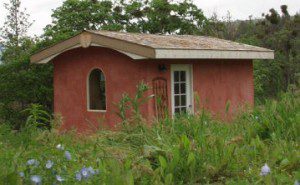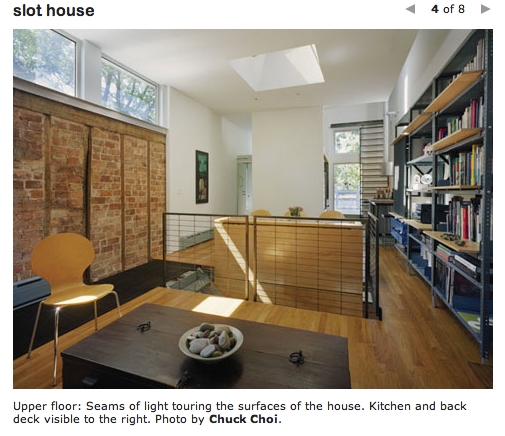by Gabriella Morrison
Straw bale construction is a wonderful building technique. It yields walls that are 3 times more fire resistant than standard construction, 3 times the energy efficiency of conventional construction, uses a waste material that otherwise gets burned in the field and creates huge levels of pollution, is very easy to learn even for people with no prior building experience (think stacking large Legos), and creates a beautiful home environment.
We have designed a brand new straw bale structure named the Mountain View Cabin. It is a 198sqft, no permit required structure that has been specifically designed for ease of construction, maximum use of space and for the lowest cost possible to build. The Mountain View Cabin is also the very structure that we show how to frame in our brand new “How To Frame For Straw Bale Construction”, nearly 3 hour long, DVD set. This DVD will launch for sale this Friday, July 6. With the inclusion of this DVD to our existing line of How-To instruction videos, one can learn the entire building process of how to create their own straw bale home. We now cover everything from Foundation, to Framing, To Baling (which includes electrical and plumbing installations), and finally to Plastering.
 To celebrate the upcoming launch of our new Framing DVD, we are giving away our 12,442 word, 34 page FRAMING REPORT for free. Further, everyone that downloads our Report also has the opportunity to receive the FULL ARCHITECTURAL PLANS FOR THE MOUNTAIN VIEW CABIN for Free with every purchase of our new Framing DVD when it launches. The plans are a complete set and have all of the information you need in them in order to build your own Mountain View Cabin.
To celebrate the upcoming launch of our new Framing DVD, we are giving away our 12,442 word, 34 page FRAMING REPORT for free. Further, everyone that downloads our Report also has the opportunity to receive the FULL ARCHITECTURAL PLANS FOR THE MOUNTAIN VIEW CABIN for Free with every purchase of our new Framing DVD when it launches. The plans are a complete set and have all of the information you need in them in order to build your own Mountain View Cabin.
To gain access to the Free Report, please click here:
http://strawbale.com/store/
By the way, you are under no obligation to purchase our Framing DVD when it launches this Friday if you download the Report. It is absolutely free to you.

I’m a little naive to straw construction… but I live and build in the NorthWET (Pacific Northwest.) Alot of water can move through a structure, usually from the inside-out. Exterior humidity during an 8 month wet season can cause the walls to stay damp for long periods of time.
How does straw respond to this? What techniques are used to keep things dry? What happens when it does get wet?
Abel
Hi Abel. Great question. Straw bale homes actually do really well in the Pacific Northwest (or North WET) if you prefer). The key is using the right plaster on the walls. I prefer natural hydraulic lime plaster because it is very durable yet it still allows the walls to breathe. It is also hygroscopic, so it will pull moisture out of the bales and release it to the air as soon as the amount of moisture in the air is lower than that of the walls. As you note, homes are pressurized from the inside out and so there will always be a steady movement or flow through the walls. With proper construction detailing, this becomes an advantage for the bales. If the environment in which the home is built dries out from time to time (i.e. it’s not rainy and humid ALL the time) then the straw will dry out and continue to provide excellent insulation for the home).
“NorthWET”, man that says it for sure! Especially this year. I’m also curious about the effects of continuous damp air on straw bale. I’ve seen how quickly wood gets soggy even when protected from overhead precipitation. Firewood needs to be kept stacked with lots of air space around the pieces even under cover. Completely tarping over a pile of lumber can trap too much moisture and contribute to rot. Whatever seals moisture out can also seal it in.
You hit it right on the head Alice. “Whatever seals moisture out also seals it in.” That is so incredibly true and something that a lot of builders miss. They build to keep water from getting in when really they should build to allow water to get out. The fact of the matter is that water will find its way into any structure be it through vapor, a leak somewhere, or climate humidity. The key to success is giving that moisture a way out. We do that with the plaster choice as mentioned in my above comment and in construction detailing at the foot of the wall. It’s all in the details! With those properly designed and installed, a bale house can live a happy life in wet climates. In fact, there are several in Portland, OR and Seattle, WA that are doing really well many years after their initial construction. Those are pretty wet places, so a good testament to the success of bales in the Northwest.
Couple links for your “WETters”
http://www.buildingwithawareness.com/blog/2009/04/the-pros-and-cons-of-straw-bale-wall-construction-in-green-building/
http://www.strawbale.com/assessing-moisture-in-a-straw-bale-wall/
Don’t forget to read comments either.
Caveat Emptor!
Good to know. I reluctantly passed up on straw bale construction for my art building because I assumed that it wouldn’t work here in Olympia, where it usually stays damp at least 8 months of the year – even with the occasional non-rainy day. I’m saving these links in case there’s another opportunity to build with straw bale. Thanks!
“uses a waste material that otherwise gets burned in the field and creates huge levels of pollution”
I have never, ever, seen a hay field set on fire in the united states – where is this common practice?
Slight technical difference here—straw has no food value; hay can be consumed as food. However, to your greater point—rice straw was traditionally burned after harvest…now there are a lot more regs in place to control it (see http://californiaagriculture.ucanr.org/landingpage.cfm?article=ca.v047n04p8&fulltext=yes for more info if interested).
Very important distinction is between that of straw and hay , as Emily pointed out. Hay is far too valuable a crop to burn whereas straw is simply the waste product of a grain crop.
It is true that there are a lot more regulations in place today; however, straw is still burned and pollution is still created as a result. California has lowered their burn levels, but other states are a bit behind. Oregon, for example, only reached what I would consider to be reasonable levels in 2010 and I suspect other states are also still allowing burning.
Even without the burning, what happens to the straw? It often ends up in the landfills, fed to cattle (even though it is only roughage and has little or no actual food value), or rotted away. The last one is perhaps the worst option. Many farmers have come to flooding their fields to speed the decay of the straw (rice farmers in particular). This is a HUGE waste of water, our most precious resource. So even when they are no longer burning the straw, it is still causing environmental issues that need to be addressed. If the straw is used as insulation (a market that is needed anyway) then all the better.
I have been fascinated by, and learning about, straw bale construction for many years.
However, as a long-time mulch gardener, straw that results from EFFICIENT grain harvesting/threshing is very useful as mulch where I WANT it to rot away (otherwise it’s NOT). So, if it is such a waste product why isn’t cheaper than hay (by more than $1)? I have purchased truckloads before, but sometimes it’s less trouble for me to buy hay.
It is not necessary to waste straw because modified farming methods can change that (http://www.onestrawrevolution.net/One_Straw_Revolution/Videos.html).